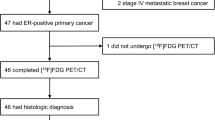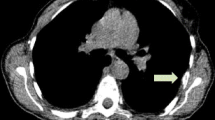Abstract
16α-[18F]Fluoro-17β-estradiol (FES) is an estrogen receptor (ER) ligand used for the detection of ER-positive malignant tumors such as breast cancer. We recently reported the feasibility of combined FES-and 2-[18F]fluoro-2-deoxy-D-glucose (FDG)-positron emission tomography (PET) scans for the differential diagnosis of endometrial tumors. ER expression measured by FES-PET was preserved in endometrial hyperplasia, whereas ERs were assumed to be reduced in endometrial carcinoma with accelerated glucose metabolism measured by FDG-PET. We report two postmenopausal patients under suspicion of endometrial carcinoma on the basis of cytology and/or magnetic resonance imaging (MRI), who were on tamoxifen treatment since undergoing surgery for breast cancer. Pelvic MRI suggested endometrial carcinomas, whereas FDG-and FES-PET showed no abnormal tracer accumulation. A postoperative histopathologic examination revealed that the lesions were endometrial hyperplasias with no malignant findings. FES-PET enables us to evaluate the ERα expression of endometrium noninvasively, whereas the evaluation of ER expression using FES-PET requires careful attention regarding the influence of hormonal therapy because tamoxifen greatly affects FES accumulation of even endometrial hyperplasia, which should be an FES-avid lesion.
Similar content being viewed by others
References
Kurman RJ, Kaminski PF, Norris HJ. The behavior of endometrial hyperplasia: a long-term study of “untreated” hyperplasia in 170 patients. Cancer 1985;56:403–412.
Havrilesky LJ, Kulasingam SL, Matchar DB, Myers ER. FDG-PET for management of cervical and ovarian cancer. Gynecol Oncol 2005;97:183–191.
Mintun MA, Welch MJ, Siegel BA, Mathias CJ, Brodack JW, McGuire AH, et al. Breast cancer: PET imaging of estrogen receptors. Radiology 1988;169:45–48.
McGuire AH, Dehdashti F, Siegel BA, Lyss AP, Brodack JW, Mathias CJ, et al. Positron tomographic assessment of 16α-[18F]fluoro-17β-estradiol uptake in metastatic breast carcinoma. J Nucl Med 1991;32:1526–1531.
Dehdashti F, Mortimer JE, Siegel BA, Griffeth LK, Bonasera TJ, Fusselman MJ, et al. Positron tomographic assessment of estrogen receptors in breast cancer: comparison with FDGPET and in vitro receptor assays. J Nucl Med 1995;36:1766–1774.
Dehdashti F, Flanagan FL, Mortimer JE, Katzenellenbogen JA, Welch MJ, Siegel BA. Positron emission tomographic assessment of “metabolic flare” to predict response of metastatic breast cancer to antiestrogen therapy. Eur J Nucl Med 1999;26:51–56.
Mortimer JE, Dehdashti F, Siegel BA, Trinkaus K, Katzenellenbogen JA, Welch MJ. Metabolic flare: indicator of hormone responsiveness in advanced breast cancer. J Clin Oncol 2001;19:2797–2803.
Linden HM, Stekhova SA, Link JM, Gralow JR, Livingston RB, Ellis GK, et al. Quantitative fluoroestradiol positron emission tomography imaging predicts response to endocrine treatment in breast cancer. J Clin Oncol 2006;24:2793–2799.
Tsujikawa T, Okazawa H, Yoshida Y, Mori T, Kobayashi M, Tsuchida T, et al. Differential diagnosis of endometrial hyperplasia and cancer using combined 18F-FES and 18F-FDG PET (abstract). J Nucl Med 2007;48Suppl 2:386P.
Kiesewetter DO, Kilbourn MR, Landvatter SW, Heiman DF, Katzenellenbogen JA, Welch MJ. Preparation of four fluorine-18-labeled estrogens and their selective uptakes in target tissues of immature rats. J Nucl Med 1984;25:1212–1221.
Mori T, Kasamatsu S, Mosdzianowski C, Welch MJ, Yonekura Y, Fujibayashi Y. Automatic synthesis of 16α-[18F]fluoro-17β-estradiol using a cassette-type [18F]fluorodeoxyglucose synthesizer. Nucl Med Biol 2006;33:281–286.
Hu K, Zhong G, He F. Expression of estrogen receptors ERα and ERβ in endometrial hyperplasia and adenocarcinoma. Int J Gynecol Cancer 2005;15:537–541.
Killackey MA, Hakes TB, Pierce VK. Endometrial adenocarcinoma in breast cancer patients receiving antiestrogens. Cancer Treat Rep 1985;69:237–238.
Yoo J, Dence CS, Sharp TL, Katzenellenbogen JA, Welch MJ. Synthesis of an estrogen receptor β-selective radioligand: 5-[18F]fluoro-(2R*,3S*)-2,3-bis(4-hydroxyphehyl) pentanenitrile and comparison of in vivo distribution with 16α-[18F]fluoro-17β-estradiol. J Med Chem 2005;48:6366–6378.
Tsuchida T, Okazawa H, Mori T, Kobayashi M, Yoshida Y, Fujibayashi Y, et al. In vivo imaging of estrogen receptor concentration in the endometrium and myometrium using FES PET: influence of menstrual cycle and endogenous estrogen level. Nucl Med Biol 2007;34:205–210.
Wang BY, Kalir T, Sabo E, Sherman DE, Cohen C, Burstein DE. Immunohistochemical staining of GLUT1 in benign, hyperplastic, and malignant endometrial epithelia. Cancer 2000;88:2774–2781.
Cohen I, Beyth Y, Altaras MM, Shapira J, Tepper R, Cardoba M, et al. Estrogen and progesterone receptor expression in postmenopausal tamoxifen-exposed endometrial pathologies. Gynecol Oncol 1997;67:8–15.
Wilder JL, Shajahan S, Khattar NH, Wilder DM, Yin J, Rushing RS, et al. Tamoxifen-associated malignant endometrial tumors: pathologic features and expression of hormone receptors estrogen-α, estrogen-β and progesterone: a case controlled study. Gynecol Oncol 2004;92:553–558.
Furr BJ, Nicholson RI. The pharmacology and clinical uses of tamoxifen. Pharmacol Ther 1984;25:127–205.
Fabian C, Sternson L, El-Serafi M, Cain L, Hearne E. Clinical pharmacology of tamoxifen in patients with breast cancer: correlation with clinical data. Cancer 1981;48:876–882.
Yoshida Y, Kurokawa T, Sawamura Y, Shinagawa A, Okazawa H, Fujibayashi Y, et al. The positron emission tomography with F18 17β-estradiol has the potential to benefit diagnosis and treatment of endometrial cancer. Gynecol Oncol 2007;104:764–766.
Author information
Authors and Affiliations
Corresponding author
Rights and permissions
About this article
Cite this article
Tsujikawa, T., Okazawa, H., Yoshida, Y. et al. Distinctive FDG and FES accumulation pattern of two tamoxifen-treated patients with endometrial hyperplasia. Ann Nucl Med 22, 73–77 (2008). https://doi.org/10.1007/s12149-007-0075-2
Received:
Accepted:
Issue Date:
DOI: https://doi.org/10.1007/s12149-007-0075-2




